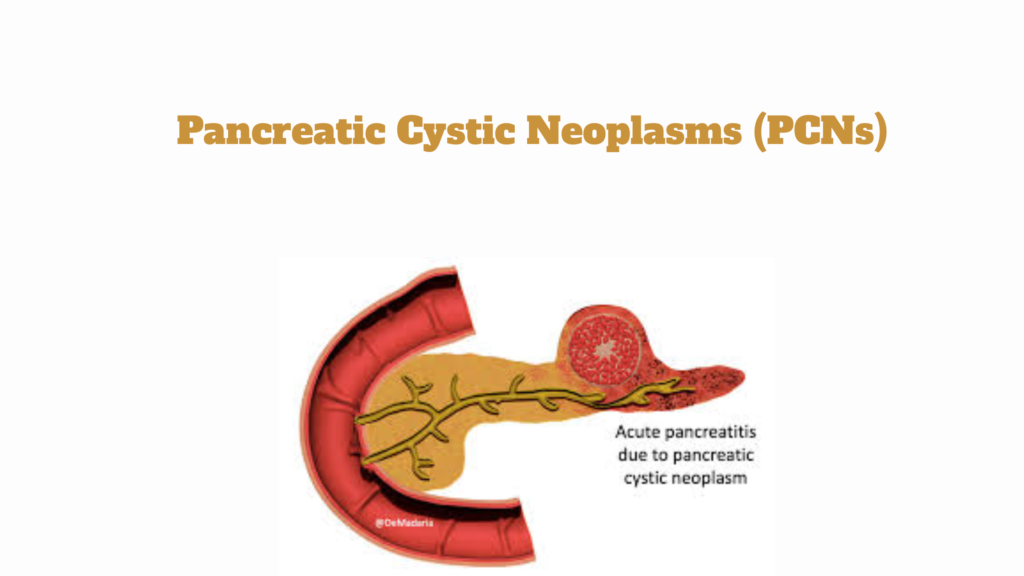
Pancreatic Cystic Neoplasms (PCNs) are a diverse group of lesions originating from the pancreas. They range from benign to malignant and are often detected incidentally during imaging studies for other conditions. Understanding their types, diagnostic approaches, and management strategies is crucial for appropriate patient care.
🧬 Types of Pancreatic Cystic Neoplasms
- Serous Cystic Neoplasm (SCN)
- Characteristics: Typically benign, SCNs are often asymptomatic and most commonly found in the body or tail of the pancreas. They are characterized by numerous small cysts filled with clear fluid and may present a central scar upon imaging.
- Demographics: Predominantly affect women, with a mean age of diagnosis around 62 years.
- Management: Generally, no treatment is necessary unless symptoms arise. Surgical intervention is rare and usually reserved for symptomatic cases or those with complications. (jgo.amegroups.org, journals.lww.com)
- Mucinous Cystic Neoplasm (MCN)
- Characteristics: These are typically larger cysts with thick walls and mucin-producing epithelium. They often lack communication with the pancreatic duct system.
- Demographics: Almost exclusively affect middle-aged women.
- Management: Due to the potential for malignancy, surgical resection is recommended, particularly if the lesion is symptomatic or shows signs of high-grade dysplasia. (ncbi.nlm.nih.gov)
- Intraductal Papillary Mucinous Neoplasm (IPMN)
- Characteristics: IPMNs are cystic lesions that communicate with the pancreatic duct and produce mucin. They can be classified into main duct, branch duct, or mixed types based on their location and extent.
- Demographics: More common in older adults, with a slight male predominance.
- Management: Surgical resection is considered for main duct IPMNs or branch duct IPMNs with high-risk features, such as large size, mural nodules, or main duct dilation.
- Solid Pseudopapillary Neoplasm (SPN)
- Characteristics: A rare tumor with both solid and cystic components, often exhibiting a well-defined capsule.
- Demographics: Predominantly affects young women.
- Management: Surgical resection is the treatment of choice, as these tumors have malignant potential but are generally indolent.
- Cystic Neuroendocrine Tumor
- Characteristics: These tumors arise from the endocrine cells of the pancreas and can present with cystic features.
- Demographics: Can occur at any age, with no strong gender predilection.
- Management: Treatment involves surgical resection, and the prognosis depends on the tumor’s grade and stage.
🩺 Diagnostic Approach
- Imaging Studies: CT scans, MRI, and endoscopic ultrasound (EUS) are essential for identifying cystic lesions, determining their characteristics, and assessing for features suggestive of malignancy.
- Cyst Fluid Analysis: EUS-guided fine needle aspiration (FNA) allows for cytological examination and biochemical analysis of cyst fluid, aiding in differentiation between various cystic lesions.
- Genetic Testing: Particularly in cases of MCN, testing for mutations such as KRAS or GNAS can provide additional diagnostic information.(ncbi.nlm.nih.gov)
🧭 Management Strategies
- Surveillance: Asymptomatic, low-risk lesions may be monitored with periodic imaging to detect any changes in size or appearance.
- Surgical Intervention: Indicated for symptomatic lesions, those with features concerning for malignancy, or those causing complications such as obstruction or pancreatitis.
- Endoscopic Procedures: In some cases, endoscopic drainage or resection may be considered, especially for IPMNs or SPNs located in accessible areas.(meridian.allenpress.com)
